
Next: A Goddess has many foes – Terrible pictures and texts from all the world.
And: A Goddess great in fashion – The Goddess is often fashionable but not sexy.
1. A Thousand prehistoric Idols
2. A Lady but not yet a Woman
3. The Snake of Creation
4. Rogues versus the Goddess
5. Semites and the mean God
6. Higher Animals are more divine
7. The greatest and best Animal
8. The Mermaid in her own venom
9. The Fantasy Monster who heals
10. The Navel of the World
11. The Portals of Wisdom

Rejoice, oh my world! Finally this planet's deity has her coming out. Already 300.000 years ago first idols were made of her. The religion of the Goddess was the first religion of planet Earth. Well, UTR is the only true religion after all.
The oldest ever Artwork on Earth
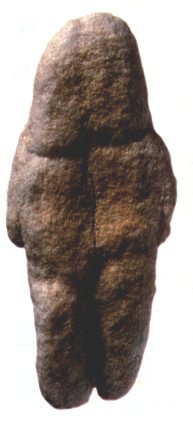
A multitude of very ancient idols and legends leaves no doubt that once the one and only religion of Earth was the religion of the great Goddess. For hundreds of thousands of years believers accepted her as the ruling worldly power. But in the old days it was not possible to accurately separate our Goddess from Greys, cosmic devils.
Wow, this statuette is maybe 300.000 years old! This means it is by far the oldest work of art ever found on planet Earth! The Venus of Tan-Tan was discovered in Morocco. That find wasn't even recognized as some idol, since the experts did not expect to find artifacts (tools, artwork etc.) in layers of such a high age. We can take this idol as one example that the Goddess tries for a long time now to make humans get more intelligent, and to introduce into their minds an artist's sense for beauty. Beauty was supposed to mark, for the better humans, the path that leads towards higher development in evolution. To Surtungs (children of darkness) and to ugly and adverse people often God's word came to not make pictures of God. The more or less ugly often disliked her. But in the older days just some 'dwarfs' had dedicated their most precious and beautiful works of art to the Goddess. A man who is not good looking, and who with reason prefers to veil his murky isha, can still have a sense for the true beauty of women. We can't call those primitive subhumans of the species 'homo erectus' beautiful who lived in Morocco at that early time. Only the Goddess already imagined well how super the looks of her superhumans of the future shall be, one fine day. With her many idols she showed to them, firstly, that she is with them.
1. A Thousand prehistoric Idols
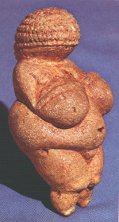 Once all the world believed into a goddess. Many images show her, often without a
face and xxx-large, like this 'Venus von Willendorf' (Austria). She just is
a whale-fish (congera), but also a woman with a sense for natural beauty. Many
men became 'sadly randy' regarding the Goddess, with the consequence that negative
experiences hit them. Those who knew her not tended to think of her as a spirit.
When hunters hoped for rich booty and peasants for a good harvest, then they
asked this Mother Nature to help. Artists often took an obese matron as a human
example, since the Greys supplied them with morbid ideas. The Nordic and the
Goths simply called the Earth Goddess 'Frau Gode', the 'Good Lady'. Rügen
in Deutschland was her holy isle. The seafaring people of the Reanen (Ranen) were
spreading her cult with boats. People revered Ga-Ewa (Gaia) as a mermaid (Ran) or
Mother Earth (Nerthus), with festive parades especially in lent (spring), since she
then warms up the land. In ancient Sweden the Goddess of Earth Nerthus was lately
reinterpreted as Njørd, god of the sea. Some vikings and barbarians didn't hold her in
high esteem. That was especially the case for legendary Siegfried, who converted
to Christianity. But it is known that this churl soon ended tragically, betrayed
by women who now were at daggers drawn, and also by Christians without honor, who
subsequently led nearly the entire Burgundian tribe into annihilation by the Huns.
Once all the world believed into a goddess. Many images show her, often without a
face and xxx-large, like this 'Venus von Willendorf' (Austria). She just is
a whale-fish (congera), but also a woman with a sense for natural beauty. Many
men became 'sadly randy' regarding the Goddess, with the consequence that negative
experiences hit them. Those who knew her not tended to think of her as a spirit.
When hunters hoped for rich booty and peasants for a good harvest, then they
asked this Mother Nature to help. Artists often took an obese matron as a human
example, since the Greys supplied them with morbid ideas. The Nordic and the
Goths simply called the Earth Goddess 'Frau Gode', the 'Good Lady'. Rügen
in Deutschland was her holy isle. The seafaring people of the Reanen (Ranen) were
spreading her cult with boats. People revered Ga-Ewa (Gaia) as a mermaid (Ran) or
Mother Earth (Nerthus), with festive parades especially in lent (spring), since she
then warms up the land. In ancient Sweden the Goddess of Earth Nerthus was lately
reinterpreted as Njørd, god of the sea. Some vikings and barbarians didn't hold her in
high esteem. That was especially the case for legendary Siegfried, who converted
to Christianity. But it is known that this churl soon ended tragically, betrayed
by women who now were at daggers drawn, and also by Christians without honor, who
subsequently led nearly the entire Burgundian tribe into annihilation by the Huns.
The Goddess needs wise ladies
 The Goddess often seems to be just much too fat, and then she disguised herself!
Here I artfully worked up one very old idol. Often a matron played the 'bot'
behind such an all-too-fat image, a tale-teller and singer or a whore, a vålva
(seer) or healer or leading lady. Such a great mother was supposed to know the arts
of sorcery. That means that she would see and know things, for instance the
cycles of the women. Some wise women knew more of the world than contemporary
medics, who are sadly called “demigods in white” at times, when
they subconsciously spiritually intercept the connection of the Goddess to her
world. Other witches though believed, like many infidels do too, in the wonder-power
of drugs and magical rituals. So the quality of such wise women was essential, it
would allow a tribe or people to thrive. The Goddess constantly tries to bring
good ideas to the women. But that was especially difficult with those fat ladies.
So the weakness of the Goddess is displayed when we find that many idols show her as
an extremely overweight woman, unfit and with out-of-control drives and eating habits. Much
better results she achieves with young women, those who are young and fit enough to endure the
uncanny burdens and times of distress, that come to people as they learn
to love the Goddess. The perennial big problem, that the Earth Goddess always
had, is that she cannot speak. Only with the help of a savior, Ewa is able to
reveal herself to the world. Before my days she needed to search help from
sensitive women. And then their silliness was to blame when the Goddess was
wrongly perceived, and confused with those constantly jabbering, distracting and secretly hurting Greys.
The Goddess often seems to be just much too fat, and then she disguised herself!
Here I artfully worked up one very old idol. Often a matron played the 'bot'
behind such an all-too-fat image, a tale-teller and singer or a whore, a vålva
(seer) or healer or leading lady. Such a great mother was supposed to know the arts
of sorcery. That means that she would see and know things, for instance the
cycles of the women. Some wise women knew more of the world than contemporary
medics, who are sadly called “demigods in white” at times, when
they subconsciously spiritually intercept the connection of the Goddess to her
world. Other witches though believed, like many infidels do too, in the wonder-power
of drugs and magical rituals. So the quality of such wise women was essential, it
would allow a tribe or people to thrive. The Goddess constantly tries to bring
good ideas to the women. But that was especially difficult with those fat ladies.
So the weakness of the Goddess is displayed when we find that many idols show her as
an extremely overweight woman, unfit and with out-of-control drives and eating habits. Much
better results she achieves with young women, those who are young and fit enough to endure the
uncanny burdens and times of distress, that come to people as they learn
to love the Goddess. The perennial big problem, that the Earth Goddess always
had, is that she cannot speak. Only with the help of a savior, Ewa is able to
reveal herself to the world. Before my days she needed to search help from
sensitive women. And then their silliness was to blame when the Goddess was
wrongly perceived, and confused with those constantly jabbering, distracting and secretly hurting Greys.
That lady remained a mystery. Often therefore the Goddess was shown as a veiled dame.
On Rügen they allegedly only used a wooden pole with a ball on top of it. That
idol was veiled with a cloth, nobody was supposed to see it. Many stories from Britain
report of a White Lady that was seen as a ghost. People then speculated much whose
ghost that might have been. But verily, only the ever same White Goddess had made
herself seen, while at the same time she remained a mystery. Sadly the Greys are
distorting the image of the Goddess. People who regard inner visions, for instance
under the influence of religions or drugs, may lose lifeforce as a consequence.
Visions can be harmful. Nevertheless for women it was natural to see and discern
the Goddess, who would protect and help them. Where the Goddess is well respected
and liked, there it's easier for a woman to excel and also reap some respect.
The Goddess as a dildo

Experts call this an idol of the goddess, but it rather looks like a stone-age
dildo. Masturbation should not be a taboo. But those who hold on to the goddess
often have to endure nasty miracles. Their eating habits would get out of control
and they would feel sexually stimulated. Those who didn't understand this often
blamed the Goddess.
“The Frau Gaue is now all dead!” This is what the 'dwarfs' from the Mark Brandenburg
region shouted when Christians had abolished the religion of the Goddess (Gaia) in Deutschland
(Germany). At that time the Goddess had nearly retreated from the world. Those Greys were also
sexually harassing her badly. She could not make humankind understand that she is good. So she
simply chose to hide for a while.
Clothes are for sale, the Goddess is not

This pretty classical dress is for sale, but the beauty of this model is a work of Mother Nature. The true Goddess of Love does not charge people for her work. She likes to pose as a beautiful and noble woman, but she ain't that yet. She wants to be the Kaiserin among beautiful people. To make this happen, already in ancient times Ewa retreated from the lesser women, she withheld her spiritual and creative support. Only when a woman fits well to a pretty dress, then the noble Goddess of Love also likes to appear as an erotic goddess.
2. A Lady but not yet a Woman
 This 'Fanny' was found in a cave in Deutschland. There early modern white humans
(the Cromagnon species) started with their first workshop of arts. Old-time
experts cannot well explain why the first modern humans should start with their first
respectable culture of all the world at the cold edge of Europe. Europe always was the
pacemaker of culture and civilization, while ancient Indio America or Negro Africa
never got past the stone age. In the heartland of Europe the Earth Goddess planned
to erect her realm of God a long time ago, and she showed that early. Fanny at
least looks young and erotic for an idol. Often some sensible artist would take
a magical or erotic woman as a model. He would know this woman, or he would
only see her in his visions, and with his artwork he would help to create her. This
divine support of humans with the work of creation was understood as the Holy Spirit.
The typical artist tried to depict the Goddess as a wondrous lady. That happens since
the Goddess often appears to humans under the portal (likeness) of a spiritually
powerful woman. The Goddess would often use the tight spiritual connection that many
children have to their mothers. A seer would often recognize this ghost as some person
that he knew. A dead ancestress seems to have turned into a spirit, but it's not really
her. The seer or artist would sometimes notice that the wesenheit (virtual personality)
of the spirit seems to be quite different from the living or dead person that it
seemed to impersonate. He would often sense that artful inspiration came to him from
an entity that was all different from a mortal woman. Thousand images and statues
show the creative efforts to depict someone who shows up in ghostly visions as a woman
without really pretending that she already is one.
This 'Fanny' was found in a cave in Deutschland. There early modern white humans
(the Cromagnon species) started with their first workshop of arts. Old-time
experts cannot well explain why the first modern humans should start with their first
respectable culture of all the world at the cold edge of Europe. Europe always was the
pacemaker of culture and civilization, while ancient Indio America or Negro Africa
never got past the stone age. In the heartland of Europe the Earth Goddess planned
to erect her realm of God a long time ago, and she showed that early. Fanny at
least looks young and erotic for an idol. Often some sensible artist would take
a magical or erotic woman as a model. He would know this woman, or he would
only see her in his visions, and with his artwork he would help to create her. This
divine support of humans with the work of creation was understood as the Holy Spirit.
The typical artist tried to depict the Goddess as a wondrous lady. That happens since
the Goddess often appears to humans under the portal (likeness) of a spiritually
powerful woman. The Goddess would often use the tight spiritual connection that many
children have to their mothers. A seer would often recognize this ghost as some person
that he knew. A dead ancestress seems to have turned into a spirit, but it's not really
her. The seer or artist would sometimes notice that the wesenheit (virtual personality)
of the spirit seems to be quite different from the living or dead person that it
seemed to impersonate. He would often sense that artful inspiration came to him from
an entity that was all different from a mortal woman. Thousand images and statues
show the creative efforts to depict someone who shows up in ghostly visions as a woman
without really pretending that she already is one.
Some idols look grotesque with a cause
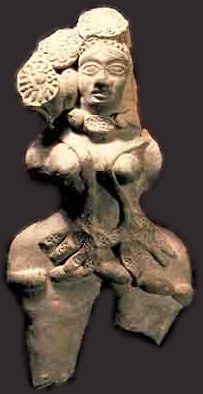 Such idols of the Goddess were frequent in the non-Aryan India of the antiquity.
Popular was at first the color dark gray, is was a result of the burning process.
These female curves are 'better than optimum', and they were typical for ancient
Indian art. Typical is also the depiction of the Goddess, looking out of a circle
of chakras (wheels) like of a window. In the view of UTR those chakras symbolize
here the gyrating gravity wheels of a betyle. This statuette was surely supposed
to be a work of erotic art, but it turns out to be rather grotesque and puts you
off. In the old days the Goddess was mostly busy in the private sector, so to say.
But not only this idol reveals that she is a dame and not a courtesan. The typical
depictions of a goddess are often not meant to be erotic. The Goddess only grants
natural beauty to selected women, it is often a sign of quality. These are meant
to look attractive. Many a murky woman however doesn't want to realize that. She
makes herself broad and takes on expensive jewelry. But nothing can really mask
the fact that she is just not pretty and withers quickly.
Such idols of the Goddess were frequent in the non-Aryan India of the antiquity.
Popular was at first the color dark gray, is was a result of the burning process.
These female curves are 'better than optimum', and they were typical for ancient
Indian art. Typical is also the depiction of the Goddess, looking out of a circle
of chakras (wheels) like of a window. In the view of UTR those chakras symbolize
here the gyrating gravity wheels of a betyle. This statuette was surely supposed
to be a work of erotic art, but it turns out to be rather grotesque and puts you
off. In the old days the Goddess was mostly busy in the private sector, so to say.
But not only this idol reveals that she is a dame and not a courtesan. The typical
depictions of a goddess are often not meant to be erotic. The Goddess only grants
natural beauty to selected women, it is often a sign of quality. These are meant
to look attractive. Many a murky woman however doesn't want to realize that. She
makes herself broad and takes on expensive jewelry. But nothing can really mask
the fact that she is just not pretty and withers quickly.
This work of art shows the old and modern dilemma of India, if we interpret it
correctly. It comes from a period of time when the Goddess was accepted mainly
by the coloreds. When the Aryans came to India, the pariahs and dasyus realized
that those more Europid (Caucasian) humans were of better quality, and were having the support
of the great Goddess. Those Aryans often didn't notice that. In the Middle Ages
then Buddhism and Islam had nearly pushed aside the better spirit of the Goddess.
Even for many Hindus the Goddess of Earth was now only a Yakshi, a servant nymph
of lust. Bedeviled by a dark cosmic female power, at that time many puny Indians
regarded themselves als half-divine descendants of Surya or Soma (Sun and Moon,
often Ga-Dora and Ga-Sama hid behind them). Blinded by devilish Greys even many a
court dame or rich lady, small and ugly, thought that she was a goddess (devi),
or a great goddess (mahadevi), or even a threefold great goddess
(trailokyamahadevi)! Right then the Islamic great mogul Akhbar declared that his
wife was the 'Maria of that age'. It was the bad age of Maria and Kali (Kaliyuga).
The Muslim Akhbar just hadn't understood correctly what the muezzins would call
out: “Allah-hu Akhbar” means 'God is great' but not 'God is Akhbar'!
When short-legged Orientals think wrongly then often their silly and murky women
are a part of this process. Because false religions make mainly low-quality men
get randy and socially incompetent, India is today a miserable country of the
third world only, that has stifling masses of dark low-quality people. Only a
new and true religion can spiritually purge that land and save it. The Indians
must realize that there is a divine glamor that only shines from beautiful
Europid humans, as a sign that they are the ones who shall inherit the world.
The Snake at every Ear

There is lifeforce of our good Goddess in every woman. But also Greys, evil cosmic snakes, sneak into the human mind. Any good woman should try to take in the wisdom of the Goddess only.
Intuition is a normal process that is badly understood so far. The modern lore is correct that 'morphological fields' make many people think rather identical things. But there is also the phenomenon that thoughts and emotions may bring you lifeforce or not. Women trust a lot more than men into the things that their feelings and inner voices tell them. Those inner voices seem to come from the own mind or from other people. With the UTR we can learn that good or non-good powers from beyond (Uthras) manipulate intuition. Those Semitic dark prophets from the desert, Moses and Jesus and Mohammed, stood much under the influence of evil stars, because of the heat and their more simple minds. Sadly those evil Greys have a strong influence on some humans, and they are stronger at coloreds and bad people. Depending on their mood the Greys may make the bad people become strong or direct them into evil traps. The Earth Goddess often only communicates a few hints, by her typical lent ways. Sofia Ewa is much more sensitive and often links rational intuition at some event or even a bit of magic. You can help her reach you by way of self discipline and inner friendliness. But she rather stays away from aged people, since she must save energy.
3. The Snake of Creation
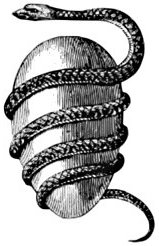 Greek (Orphic) traditions taught that once upon a time the Goddess danced above
the waves of the ocean of this world. Her egg of this world was created in the
dark of night. It fell into the ocean and was hatched out by Ophion, the snake
of the world. From this egg then dry land was born, and everything that lives
in this world too. This ancient myth describes the birth of the Goddess in space
and her voyage with a meteorite down to Earth. The story goes that the singer
Orpheus first thought out this myth. Often creative artists get nearer to the
Goddess, who does not reveal her secrets to anyone. Even while poets think that
a 'Muse' talks to them, mostly Ewa tells them things or not, sometimes using the
treacherous Grey Ga-Musa as a badly performing helper. It played an important role
that Orpheus is one of the heroes of my one opera Medewa.
Greek (Orphic) traditions taught that once upon a time the Goddess danced above
the waves of the ocean of this world. Her egg of this world was created in the
dark of night. It fell into the ocean and was hatched out by Ophion, the snake
of the world. From this egg then dry land was born, and everything that lives
in this world too. This ancient myth describes the birth of the Goddess in space
and her voyage with a meteorite down to Earth. The story goes that the singer
Orpheus first thought out this myth. Often creative artists get nearer to the
Goddess, who does not reveal her secrets to anyone. Even while poets think that
a 'Muse' talks to them, mostly Ewa tells them things or not, sometimes using the
treacherous Grey Ga-Musa as a badly performing helper. It played an important role
that Orpheus is one of the heroes of my one opera Medewa.
Later Zeus (Divus, God) was
seen as God the father, his godly wife was called Hera (Lady, Mistress). Many
believed that this couple would live on top of the mountain of Olymp (in Greece). But in
holy Delphi they better knew the Goddess. There she was known as the snake Ga or Ge
of the Earth, the one who gave the correct oracles. But she lost much popularity
when the volcano eruption of Thera badly hit the region. That was the event that
later was interpreted as the end of the Titans. Priests taught that those
good half-divine humans had been vanquished by Zeus and the Olympic divinities,
with the help of monsters with 100 arms (Hekatoncheiren, that meant volcano clouds).
Despite of this setback the cult of the Earth Goddess still remained common
in Greece. We read of snake cults for instance in the legend of Kadmos the Phoenician.
They didn't blame Mother Earth for the natural catastrophe. And it is no coincidence that Thera later
was renamed into Santorin. That is a Dor-Name which refers to Ga-Dora. That Grey also hid
in ancient Greek myths behind Pandora with the box, the legendary bringer of all evil.
The good Goddess Ga-Ewa indeed created this world, but Greys like Ga-Dora added evil to it.
Ka, the force of eternal life
 Ancient Egyptian religion had it that life does not end with death. Old-time Egyptians
held on to the vague belief that a dead person would somehow live on in it's mummy, to dwell
in a tomb and secretly eat from the offerings that paid priests would bring.
It is of course utter nonsense to believe that a dead body or a tomb can harbor a working
mind. On the other hand there definitely exists a mysterious lifeforce. Old-time Egyptian religion
called this lifeforce Ka. UTR links this name to the family name Ga, the name of all good or
bad congeras of the 'Children of Anna'. In some ancient Egyptian tombs this lifeforce was well
symbolized by a giant snake. But who was this snake really? Ancient Egyptian priests
thought that several female deities could appear as a snake (or also as a lioness). Originally
the Ka was seen as the force of the goddess Neith (a Ga-Nesa name). This goddess of war was called
“The Terrible”. UTR links the portal Neith to the Greys of the nearby family Fe. They and
the Ga-Greys, and other congeras and other Uthras too use N-rays (pulsar spikes), who occasionally
cause poltergeist phenomena and static 'charge'. By this way they can power up a human body or suck
away his lifeforce. They can not keep a dead person alive, as a spirit or an undead mummy. A man
lives and dies fast, and even his name may soon vanish in the fog of chaos. Only our
snake of creation nearly lives forever and brings divine order to her planet. Her name is not only
Ga but Ga-Ewa. The Titans knew her name (Gaia), but the ancient Egyptians didn't get that far with
their religion. UTR links such deficits of insight to the race and to the region. While
the Earth Goddess gets stronger it becomes clearer that the lifeforce Ka is really her force,
and that of the other good congeras of the family Ga, of the Interplanetary Alliance of Humanoids
within the big bear stream (in the constellation Big Dipper).
Ancient Egyptian religion had it that life does not end with death. Old-time Egyptians
held on to the vague belief that a dead person would somehow live on in it's mummy, to dwell
in a tomb and secretly eat from the offerings that paid priests would bring.
It is of course utter nonsense to believe that a dead body or a tomb can harbor a working
mind. On the other hand there definitely exists a mysterious lifeforce. Old-time Egyptian religion
called this lifeforce Ka. UTR links this name to the family name Ga, the name of all good or
bad congeras of the 'Children of Anna'. In some ancient Egyptian tombs this lifeforce was well
symbolized by a giant snake. But who was this snake really? Ancient Egyptian priests
thought that several female deities could appear as a snake (or also as a lioness). Originally
the Ka was seen as the force of the goddess Neith (a Ga-Nesa name). This goddess of war was called
“The Terrible”. UTR links the portal Neith to the Greys of the nearby family Fe. They and
the Ga-Greys, and other congeras and other Uthras too use N-rays (pulsar spikes), who occasionally
cause poltergeist phenomena and static 'charge'. By this way they can power up a human body or suck
away his lifeforce. They can not keep a dead person alive, as a spirit or an undead mummy. A man
lives and dies fast, and even his name may soon vanish in the fog of chaos. Only our
snake of creation nearly lives forever and brings divine order to her planet. Her name is not only
Ga but Ga-Ewa. The Titans knew her name (Gaia), but the ancient Egyptians didn't get that far with
their religion. UTR links such deficits of insight to the race and to the region. While
the Earth Goddess gets stronger it becomes clearer that the lifeforce Ka is really her force,
and that of the other good congeras of the family Ga, of the Interplanetary Alliance of Humanoids
within the big bear stream (in the constellation Big Dipper).
Goddess, mother or falsche snake?

Sometimes the Goddess appears as a great mother with her divine child. The snake is not rarely a symbol of the devilish Greys too. But they don't have living mothers on their dead planets.
This temple image from the Etruscan town Veii shows Leto and Apollon, who as a Greek god of light fights against the snake of the Earth at Delphi. Here this snake has some kind of beard, a symbol for the cranes (support tubes) of any congera. The Phrygian Celt Apollon was a very cruel and unjust warlord. For instance in Delphi he raped the priestess Kastalia, who then committed suicide. Apollon had become an enemy of the snake of Earth. Subsequenty he forced all Greece to turn to his personal cult, which had it that his mother Leto was a goddess! Fractal links made this happen, who link our destiny to the neighboring world Lar and her real goddess Ga-Leta. To help there, our Earth Goddess Ga-Ewa had to let it happen that Leto, a false double of heavenly Ga-Leta, pushed her aside. It seems that this cult became especially massive among the oriental Etruskans. Luckily the Romans then abolished the bad Etruscan religion and their many somber deities.
4. Rogues versus the Goddess
Apollon became the arch-enemy of all snakes. The congeras however now started to appear under the likeness of his sister Artemis too. It happened to somber rogues that they became the enemies of the Uthras or anything female. That was typical for Persians, Aryans, Jews and Celts. Often as a consequence people started to believe that mortals or deceases humans had become deities.
When Apollon drove away the snake Ga
With the fall of the Titans Gaia had become unpopular in Greece. At Delphi during the Mycenaean era the cult of a snake called Ge or Ga dominated. But the cruel Celt Apollon then brutally abolished that cult, around the year 1270 b. We may speculate that something bad happened to this warrior that other guys of that sort experienced too. Uthras had lured him into a trap, then followed a surprise attack with mental force. Subsequently Apollon fought versus some ghostly force of evil that he took for the dragon or snake of the Earth (wrongly, we know this today). He was having no god now. Then Apollon came to the absurd idea that his mother Leto and his sister Artemis were goddesses! That is the Celtic haughtiness of people with golden hair and good genes, but with a bad conscience. From that error emerged the classical religion of the Graeco-Roman antiquity. The Greys managed to shape both Apollon and Artemis into especially bad deities. Artemis was partly seen as especially cruel. Apollon, Leto and those Bruger (Phrygians) also fostered the cult of Athene. Athene had just been a hermit woman, who had been living in Athens again after the volcano catastrophe. She was believed to be a witch. Now priests believed that Athene too had turned into a goddess after her death. In Delphi though many still sensed that behind the ghosts of Athene or Themis (Artemis) there still was the old Earth Goddess at work. Delphi was a holy place of the women, and these often came to know the Goddess better.
Beowulf as a monster hunter
In the North the legend became very important that once Beowulf had slain the monster Grendel. One anonymous cleric from Britain (a Skjøldung maybe) wrote that heroic poem. We may surely think that due to it's origin that poem is full of lies, fantasies and mean twisted stories. In some aspects Ewa was depicted as the water monster Grendel, with the savior being her son. Of these two Beowulf was not fond, since at night those two monsters allegedly sneaked into his hall killing sleepers. We must assume that the Earth Goddess did not favor Beowulf's deeds at all. The Danish cleric Saxo Grammaticus (6:2) wrote up what seems to be Beowulf's true story. Some Danes still remembered not a heroic monster slayer at the central hall Heorot, but a feared hinterland viking. Upon some island in the midst of a river he had erected his ramparts. From there he terribly raided the nearby lands and even depopulated entire regions. Hardly anyone could challenge this migrant from the South on that fortified island. But one Fridlev dared to attack Beowulf. He entered the island secretly and hid in the reeds. At night he broke into the hall of that viking chief and killed sleeping vikings. That was no heroic deed at all. We may assume that Fridlev was a Christian, a man without honor, well comparable to cowardly murderers like Olaf Tryggvason. But Beowulf's bad luck was that Christianity also had started to instil some fear into him. Beowulf now dreamed, according to this saga, of a dragon that rose from the sea and set the land on fire. So he sent out his men to track down and slay this monster. He also must have fought out mental battles with that mythical monster. When then that monster wasn't found, the legend came up that Beowulf had slain it.
The angel of heavenly life
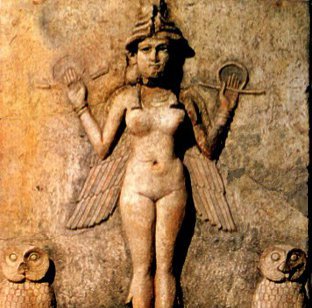
This part of a stele shows Lilith as the angel of heavenly life.
Her hair locks were artfully draped, in our view they resemble the cranes of a congera.
In the ancient Orient the great Goddess was also called Allat or Lilith. Again Ga-Leta
was behind this, our troubled neighbor. As a lewd demon of the wind Lilith is mentioned
in the Bible. We may expect people to turn their backs to such a dubious angel. But with
full right Lilith holds up two anch symbols, showing her power over life on Earth and in the sky.
She is a beast-mistress too and a goddess of wisdom, shown by the two owls. Further down
that stele shows her bird claws and two lions. I have the hunch that
the attractive and big-headed model, who once posed for this stele, may have been related to
the famous city-queen Kubaba of Kish. Those who had a quarrel with the Earth Goddess,
and who searched their sake in heaven, often came near to Ga-Leta or Ga-Rina. But
these goddesses of alien planets cannot replace our Goddess.
Jewish scholastic traditions had it that Lilith was the first wife of Adam. Priests claimed that
she was made from dirt and excrement while Adam was manufactured from 'pure dust'. While Jewish idling
bible badgers thought out all sorts of anti-feminist trash, occasionally some real secret names
from space entered into their minds. The myth goes on that when Lilith parted from Adam and flew
away into the air, the angels Sem and two Senois (Suens, swines) were sent out to bring her back using
death threats. Lilith placated these angels of death with an angel cult, and menaced to kill Jewish
children in case Israel wouldn't obey. In reality Greys like Ga-Sama (and also those of the Family Fe,
of the 'Swines in Space') fight hard to subdue Ga-Leta and to soil her reputation. Maybe it's time
for the foundation of a goddesses anti-defamation league.
5. Semites and the mean God
Semites in principle like to live in peace. But while they reproduce too much and eventually also degenerate, God seems to constantly demand of them wars and action entertainment. Many Semites don't want to better know such a God.
Jacob's fight with Yahveh
In Delphi also a holy egg was shown, that was regarded as the navel
of the world. Some decades after the time of Apollon, the biblical Jacob founded a
similar cult. Some Hebrew and Arab nomads too recognized the egg of the world as
the house of their god (Betyle, Baetyl, Bethel). Of the biblical arch-father Jacob we read
that once he hallowed the town of Bethel. It is not a coincidence that today nearly
at this place the town Ramallah lies, which we may translate as: 'God Ram'. At Bethel
one night Jacob had laid a stone under his head. Subsequently he must have dreamed well. In
the morning he thought of this stone as holy, and he put it up as an altar of his god.
Later he also erected a pillar in Bethel, we may interpret this as the idol of his
deity. Able Jacob united some Bedouin tribes in Beersheva to a mighty horde of robbers.
They raided many villages, and many non-Hebrews were slain. Now Jacob called himself Israel
(God's Fighter). That story reminds us much of Mohammed and the Arabs, a name that also
translates as 'Fighters'.
Jacob called his god Baal Brit (Bert), and not by coincidence this reminds of my own name. In
the Bible though we find the entire Hebrew people magically transformed into Ephraim,
one of the alleged sons of Jacob. Maybe later they were ashamed of their own name.
Until today Bible experts show the strong tendency to obfuscate this dirty story.
We may well think today that the good Earth Goddess was not particularly happy with
this sort of people. But she is the one and only deity of this planet Earth. Often
some people with better genes realized this sooner than others would. The consequence
was that the Greys would harass more these people, who were not really capable to separate
all these uncanny Uthras.
Of Jacob we read that one night he was attacked and beaten up by the god Yahveh, who hurt
him at the hip. The true story must have been that suddenly another desert robber had
assaulted Jacob. But, just while Jacob was attacked for real, he also was attacked
by the Greys harshly and mentally, with those N-rays. Jacob didn't react now, like
Apollon had done, with hostility. But he asked this uncanny power from beyond for
her blessing. And since the good Goddess had lost much power in Greece before that
time, she now had to deal some more with those Israelites. The consequence was that
Yahweh now appeared in the Bible as the cruel deity of the sky. Jacob the Hebrew
bandit seems to have lost his better faith in the days of his old age. Originally
Yahweh (or Jewa, written Jhwh) possibly was called 'Hewa', and seen as the virgin
of the Garden of Eden. But for some time now the Goddess lacked the power to control
her own portal. With the turnaround vocalization 'Jawe' the Goddess also turned into a false god
of the Bible. In Jacob's dream he saw God as a supreme father god of the sky, who gets visited by angels
climbing up a ladder. Such complete idiot dreams may come to an old man who still sleeps with a stone
as his pillow.
The Ghost-Harlots of Jericho
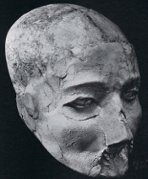 When the Goddess was not well understood as a good force, or even mistaken for an evil force, then she
often retreated. Negative experiences with the Goddess often made some dwarfs turn to false deities.
In the dry Orient the Goddess of Earth was often little liked. Already the oldest finds show that those
wandering herdsmen seemed to quarrel and build fortresses all of the time. Already in spring the
vegetation withered. In summer often there was no rain. Women wailed for the god of fertility then, a 'Mr.
Green' who had been taken away by the goddess of the underworld, who refused to give him back. Those people
were just not as wise as the Europeans, since they degenerated in the Orient. That is what ancient finds
from Jericho show, maybe the oldest town of Earth. Common idols of a goddess were found there and a menhir
(masseba). Many small axes may have symbolized the smashing power of the 'Green God' (al-Khidr) of thunder
and weather. And seven skulls were found covered with plaster. They had belonged to women of an inferior
oriental race, not typical Semites but feeble, puny and low-brow frauchen, probably temple harlots. We may
think that the temple of Jericho-2 was now seen as the holy place of seven ghost-whores. This cult of seven
spirits obviously had replaced the religion of the Goddess. The old town of Jericho fell in ruins soon
later, surely due to one of those typical troubles. It reminds of the sudden end of Jacob's horde of tribal
warriors.
When the Goddess was not well understood as a good force, or even mistaken for an evil force, then she
often retreated. Negative experiences with the Goddess often made some dwarfs turn to false deities.
In the dry Orient the Goddess of Earth was often little liked. Already the oldest finds show that those
wandering herdsmen seemed to quarrel and build fortresses all of the time. Already in spring the
vegetation withered. In summer often there was no rain. Women wailed for the god of fertility then, a 'Mr.
Green' who had been taken away by the goddess of the underworld, who refused to give him back. Those people
were just not as wise as the Europeans, since they degenerated in the Orient. That is what ancient finds
from Jericho show, maybe the oldest town of Earth. Common idols of a goddess were found there and a menhir
(masseba). Many small axes may have symbolized the smashing power of the 'Green God' (al-Khidr) of thunder
and weather. And seven skulls were found covered with plaster. They had belonged to women of an inferior
oriental race, not typical Semites but feeble, puny and low-brow frauchen, probably temple harlots. We may
think that the temple of Jericho-2 was now seen as the holy place of seven ghost-whores. This cult of seven
spirits obviously had replaced the religion of the Goddess. The old town of Jericho fell in ruins soon
later, surely due to one of those typical troubles. It reminds of the sudden end of Jacob's horde of tribal
warriors.
Better Horse than Croc
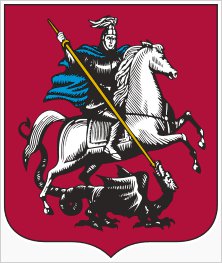
In the East some Slavs saw the Goddess a bit as a holy horse. That good faith even influenced Christian artwork. Sometimes the dragon slayer would appear as the rider on a white horse. This bright animal carries the hero into the battle against a dark monster. Not by chance the monster was often drawn from a cold-blooded crocodile. The horse is more evolved in evolution, it therefore has more of God's goodness.
This emblem of Moscow shows very impressively a scenery that is often seen in Slavic arts. The dragon slayer stings with his lance at the dragon. Often the dragon is shown gray or dark while the good horse is white. This scenery also has another good detail. The colors of the Goddess are shown here, a dark blue, white and red. That motive has nothing to do with the Jewish Bible, but it is based on authentic experiences of men and old European stories. The truth is that those Uthras could never be overpowered. Greys tend to assault humans with a sudden onslaught. Often during a crisis that would happen, or while people are searching something, or when at night they lay down to sleep. Those who knew not enough of such phenomena tended to perceive all those Uthras as dragons, mythical monsters who remind of dinosaurs. Some picture of a dragon was made from a crocodile picture, others but were influenced by monsters of alien planets. The Greys who harass us nowadays still remember the long period of time when Earth had been a nearly lost planet, with lots of hulking stupid dinosaurs.
6. Higher Animals are more divine
Greys like to jabber of lust and pain, guilt and sins. They always try a lot to mask their evil deeds or to justify them. But verily, nothing can justify these emotionless machines of destruction who are greedy like mythical movie zombies. Fortunately the Earth Goddess nevertheless manages to constantly enhance the quality of her own creatures.
Quality creatures have more goodness
 This modern painting shows the Irish-Celtic goddess Rhiannon (Rigatona) as a white
horse. The horse was not only regarded by Celts as an animal that was especially bound
to a Goddess. In the old days dolphins too were often regarded as spiritual friends
of the deities. After the Thera volcano catastrophe seafarers from Crete introduced the cult
of some dolphin to Delphi. From the time of classical antiquity, when the Goddess was still more
accepted by her humans, we have true stories telling us that dolphins even saved shipwrecked
sailors. Allegedly some intelligent super-dolphins, who live in other galaxies, even
spiritually help us here on Earth. We had researchers, like John C. Lilly, who intensely
tried to communicate with dolphins. They came to the sure result that especially dolphins
behaved in a nearly intelligent way. But we have to always keep in mind that congeras
manipulate such tests with their rays. Some of them have a special tendency to identify
with marine mammals. The better our creatures get, including humans, the more they take up
good habits. Regarding creation our objective must be to further evolve the promising
species. Evil Uthras (mainly Greys) though struggle to make creatures become more aggressive
and dangerous. We are stronger with higher evolved creatures, they are stronger with some
bad and primitive ones. Old-time experts can hardly explain why primitive marine species,
like for instance many sharks, definitely are more hostile than well developed marine
mammals. This is explainable with the notion that the good divine spirit gets nearer
to the creatures who have already developed to a certain level of quality. Not only God makes
some animals evolve and behave the way humans wish, but that is what humans work too with
their wishes and their imagination and their and God's power. Our reality is not fixed in all
details, but a lot changes naturally or due to our wishes and our creativity. Good and wise
humans will magically change all their world to the better. For our future it is supremely
important that more such humans evolve. They can help others a lot with the buildup of a high culture,
a culture that will solve many problems of politics and make life easier for all, even for wild beasts.
This modern painting shows the Irish-Celtic goddess Rhiannon (Rigatona) as a white
horse. The horse was not only regarded by Celts as an animal that was especially bound
to a Goddess. In the old days dolphins too were often regarded as spiritual friends
of the deities. After the Thera volcano catastrophe seafarers from Crete introduced the cult
of some dolphin to Delphi. From the time of classical antiquity, when the Goddess was still more
accepted by her humans, we have true stories telling us that dolphins even saved shipwrecked
sailors. Allegedly some intelligent super-dolphins, who live in other galaxies, even
spiritually help us here on Earth. We had researchers, like John C. Lilly, who intensely
tried to communicate with dolphins. They came to the sure result that especially dolphins
behaved in a nearly intelligent way. But we have to always keep in mind that congeras
manipulate such tests with their rays. Some of them have a special tendency to identify
with marine mammals. The better our creatures get, including humans, the more they take up
good habits. Regarding creation our objective must be to further evolve the promising
species. Evil Uthras (mainly Greys) though struggle to make creatures become more aggressive
and dangerous. We are stronger with higher evolved creatures, they are stronger with some
bad and primitive ones. Old-time experts can hardly explain why primitive marine species,
like for instance many sharks, definitely are more hostile than well developed marine
mammals. This is explainable with the notion that the good divine spirit gets nearer
to the creatures who have already developed to a certain level of quality. Not only God makes
some animals evolve and behave the way humans wish, but that is what humans work too with
their wishes and their imagination and their and God's power. Our reality is not fixed in all
details, but a lot changes naturally or due to our wishes and our creativity. Good and wise
humans will magically change all their world to the better. For our future it is supremely
important that more such humans evolve. They can help others a lot with the buildup of a high culture,
a culture that will solve many problems of politics and make life easier for all, even for wild beasts.
We need female emotional intelligence
Regarding the problems of our planet we need more female emotional intelligence if we want to solve them. Men too often tend to fight and fight harder against their adversaries or bad people and even against supernatural evil itself. But those who turn with zeal or even hate against evil Uthras are badly advised. Greys always have to struggle to focus their N-rays at target persons. They keep them hanging on by way of dialogs and suck away their lifeforce, while they change them to the worse. If you only think of these demons you make such standard attacks easier for them.
The hammer god and the false star
 This drawing of the hammer god Thor is so remarkably ugly and void of quality that
it makes us wonder. We can't learn more from the inscriptions, since they were written
in pseudo-runes! But that rope that Thor uses for angling resembles the cranes of
a congera. Who made this? Jews often had the tendency to occupy with bad and nonsensical
religions, and with pseudo-sorcery too. Jews often defamed the good Earth Goddess as a beast.
The Jewish dragon slayer tale 'Bel and the dragon' however was thrown out of the Bible.
Even for the Jews that was just too much of Hebrew. Dragon slayer tales are already found
in early Persian-Aryan mythology, they may remind of the UTR lore that some Lares called Parsen
are quasi the Jews of planet Lar. Here and there one such people was chosen for this bad role.
This drawing of the hammer god Thor is so remarkably ugly and void of quality that
it makes us wonder. We can't learn more from the inscriptions, since they were written
in pseudo-runes! But that rope that Thor uses for angling resembles the cranes of
a congera. Who made this? Jews often had the tendency to occupy with bad and nonsensical
religions, and with pseudo-sorcery too. Jews often defamed the good Earth Goddess as a beast.
The Jewish dragon slayer tale 'Bel and the dragon' however was thrown out of the Bible.
Even for the Jews that was just too much of Hebrew. Dragon slayer tales are already found
in early Persian-Aryan mythology, they may remind of the UTR lore that some Lares called Parsen
are quasi the Jews of planet Lar. Here and there one such people was chosen for this bad role.
The above shown scene originates from the Edda, telling how Thor once was angling the Snake
of the Earth, but had to let go that beast. There we also find the story that the god with
the hammer will slay this worm of Earth, to die instantly, while the Earth goes up in flames.
The Edda prologue of the cleric Snorri wrongly identifies Thor as the legendary herdsman Paris (the
Parse) of Troy!
In reality this weather-god with the ax of thunder was regarded as 'Mr. Green' (old Norse:
Hlorridi) since he seemed to bring vegetation with his rain.
Checking the 'Red Beard' Thor we also find several similar hatchet deities, for instance Taranis
of the Celts or Tarchund from Anatolia, or the Armenian star-deity Tir (Tishtrya). The latter
was seen as the director of the Evil Spirit (Angra Manyu) in the old Persia of Zarathustra.
There still exist adherers to the religion of that Persian prophet who are also called Parsen.
The star of the god Tir was the Sirius. From the perspective of UTR all these names are again
Dor-names. Ga-Dora wants to find here on Earth a confused 'red devil' as her paredros, who would
not bring rain and let it grow but destroy our planet in the service of another dead one. From
the point of view of Earth however the image of the Weather God is just another aspect of the Savior.
7. The greatest and best animal
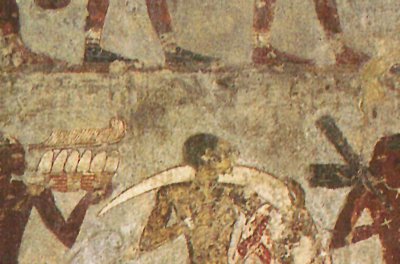 Because of it's sheer size the elephant often was regarded as a good animal, that represented
the hidden Goddess on different ways. The idea was that the biggest beast is also the best
and the ruling animal. In India this special idea is symbolized by the elephant deity Ganesh,
who but reminds us of the Grey Ga-Nesa.
In the old Egypt the elephant was possibly named the mysterious 'Beast of Seth'. That holy animal of
the deity Seth also represented the often rather white Semites and also all Europid (Caucasian)
strangers. In the Bible we find Seth consequently as one especially noble ancestor of humankind. But the
often hostile Hebrew donkey nomads (Hapiru) were disliked in Egypt, and Seth was seen as their deity too.
The problem was that those later Israelites weren't really what they believed to be, simply the best.
In Egypt at times bright Europid humans were regarded as the best race, and that is more correct.
This faith had it's effects on large parts of remote Negro Africa, that still is some kind
of hinterland of Egypt today. This painting from the tomb of Rechmire from ancient Egypt
shows Africans who bring to Egypt fascinating presents, like it was to be expected in
the old days. In long rows those bringers of donations are dark brown to pitch black.
Only one man of two, the one with the elephant tooth, is visibly of a rather white skin,
whiter than an Egyptian. Most people who regard this withered old illustration won't
think of much now. But from the point of view of UTR it's significant that just this Hebrew or
Semite African transported this white ivory tooth. Because of it's length and look
such a tooth could be seen as a symbol for the white Earth Goddess. She
prefers white humans, who are generally more reliable and constant than typical Brownies
or Negroes, when difficult work needs concentration. While a mixing of races often leads to
hard-to-socialize half-breeds, Negroes often show a tendency to not tolerate whites in Africa
at all. In Africa specific Negro genes dominate over white genes. Like in North America, God's plan
is to replace an 'aboriginal' race of lower quality altogether and swiftly with whites. But mainly
the Craeybs (evil Uthras) counter this by letting a few Negroes perform rather well in life. But even
those showpiece Negroes often develop special weaknesses, regarding their intelligence or bad habits.
Evil Uthras created the colored races for evil purposes and are having them more under control. Greys
may make them work like super slaves, but then again they make them get murderous or super-idling. Evil
Uthras make Negro males nice and seductive, but only until they placed their sperm into a woman. These
are all facts, but many infidels don't want to see them. Deluded by crazy race ideas they believe that
they can educate any low-quality humans and subhuman beings until those become top quality people.
The facts but show that the general abolition of coloreds is the best way to reduce the burden of evil
influence, that at the moment secretly ruins our planet. Where the Goddess is strong coloreds get weak.
Because of it's sheer size the elephant often was regarded as a good animal, that represented
the hidden Goddess on different ways. The idea was that the biggest beast is also the best
and the ruling animal. In India this special idea is symbolized by the elephant deity Ganesh,
who but reminds us of the Grey Ga-Nesa.
In the old Egypt the elephant was possibly named the mysterious 'Beast of Seth'. That holy animal of
the deity Seth also represented the often rather white Semites and also all Europid (Caucasian)
strangers. In the Bible we find Seth consequently as one especially noble ancestor of humankind. But the
often hostile Hebrew donkey nomads (Hapiru) were disliked in Egypt, and Seth was seen as their deity too.
The problem was that those later Israelites weren't really what they believed to be, simply the best.
In Egypt at times bright Europid humans were regarded as the best race, and that is more correct.
This faith had it's effects on large parts of remote Negro Africa, that still is some kind
of hinterland of Egypt today. This painting from the tomb of Rechmire from ancient Egypt
shows Africans who bring to Egypt fascinating presents, like it was to be expected in
the old days. In long rows those bringers of donations are dark brown to pitch black.
Only one man of two, the one with the elephant tooth, is visibly of a rather white skin,
whiter than an Egyptian. Most people who regard this withered old illustration won't
think of much now. But from the point of view of UTR it's significant that just this Hebrew or
Semite African transported this white ivory tooth. Because of it's length and look
such a tooth could be seen as a symbol for the white Earth Goddess. She
prefers white humans, who are generally more reliable and constant than typical Brownies
or Negroes, when difficult work needs concentration. While a mixing of races often leads to
hard-to-socialize half-breeds, Negroes often show a tendency to not tolerate whites in Africa
at all. In Africa specific Negro genes dominate over white genes. Like in North America, God's plan
is to replace an 'aboriginal' race of lower quality altogether and swiftly with whites. But mainly
the Craeybs (evil Uthras) counter this by letting a few Negroes perform rather well in life. But even
those showpiece Negroes often develop special weaknesses, regarding their intelligence or bad habits.
Evil Uthras created the colored races for evil purposes and are having them more under control. Greys
may make them work like super slaves, but then again they make them get murderous or super-idling. Evil
Uthras make Negro males nice and seductive, but only until they placed their sperm into a woman. These
are all facts, but many infidels don't want to see them. Deluded by crazy race ideas they believe that
they can educate any low-quality humans and subhuman beings until those become top quality people.
The facts but show that the general abolition of coloreds is the best way to reduce the burden of evil
influence, that at the moment secretly ruins our planet. Where the Goddess is strong coloreds get weak.
The holy tooth
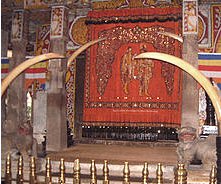 The white tooth occasionally served in Europe too as a symbol for the Earth
Goddess. One tale of the Slavs had it that once upon a time a monster with a white tooth rose with
foam from a lake. It's another version of the tale of the birth of Venus from sperm from the sky. The same
idea also explains the Buddhist cult of a holy tooth in Kandy (Candy) on Sri Lanka. Monks say this shrine
contains a tooth of Buddha (God), but the cult is linked to the elephant ritual 'Esala Perahera', and we
see big elephant tooths as the main attraction. Once again a direct view tells a different message than
priests may recount. Aryans colonized Lanka, it still shows up as you compare some to the dark Tamils.
With reason they gave up on Aryan religion, but didn't lose their better senses for what is good and true.
Those Hinayana (exclusive) Buddhists also built gigantic white stupas who resemble the body of the Earth
Goddess. In the old days the better genetic quality of the Aryans, Semites and Europids often vanished
gradually as they settled down far away from Europe. That also was due to fractal relationships to many doomed
planets of our galaxy, who are parted into six continents, of whom five are divided to the colored races.
But now the Earth Goddess can save and enhance the higher genetic quality even of whites who live out of Europe.
Candy is a part of the goddess diet, for a better growth and a prolonged time of youth, and good teeth too.
But take care of your teeth, clean them often with salt, they are more important for you than old ivory.
The white tooth occasionally served in Europe too as a symbol for the Earth
Goddess. One tale of the Slavs had it that once upon a time a monster with a white tooth rose with
foam from a lake. It's another version of the tale of the birth of Venus from sperm from the sky. The same
idea also explains the Buddhist cult of a holy tooth in Kandy (Candy) on Sri Lanka. Monks say this shrine
contains a tooth of Buddha (God), but the cult is linked to the elephant ritual 'Esala Perahera', and we
see big elephant tooths as the main attraction. Once again a direct view tells a different message than
priests may recount. Aryans colonized Lanka, it still shows up as you compare some to the dark Tamils.
With reason they gave up on Aryan religion, but didn't lose their better senses for what is good and true.
Those Hinayana (exclusive) Buddhists also built gigantic white stupas who resemble the body of the Earth
Goddess. In the old days the better genetic quality of the Aryans, Semites and Europids often vanished
gradually as they settled down far away from Europe. That also was due to fractal relationships to many doomed
planets of our galaxy, who are parted into six continents, of whom five are divided to the colored races.
But now the Earth Goddess can save and enhance the higher genetic quality even of whites who live out of Europe.
Candy is a part of the goddess diet, for a better growth and a prolonged time of youth, and good teeth too.
But take care of your teeth, clean them often with salt, they are more important for you than old ivory.
The Siren divides Deutschland
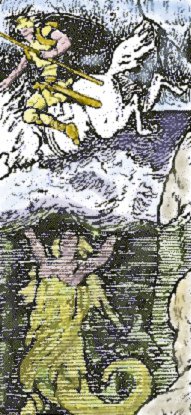
Those who hold on to the good Goddess have to suffer many quandaries while she can't surface and help. Many a hero failed due to the attacks of the Greys.
The North-Deutsche hero Wittig (Witege) was a legendary son of
a siren. Heroic tales mention him as a descendant and heir of famous Deutsche heroes of
the early days. According to a fairy tale the South-Deutsche hero Dietrich von Bern,
one legendary dragon slayer, chased Wittig into the ocean. That is the wishful dream
of some migrants and radical left-wingers, who secretly contest with the Deutsche over
their land. It's a bad tradition in Europe that a radical mob favors illegals and criminal gangs
of foreigners, Muslim tyrants and false refugees over the police and honest European right-wingers
who commit to the spirit of freedom. Well, that hostile mob badly knows the Deutsche Goddess yet.
Dietrich pursued Wittig to the coast of the Baltic Sea, and thought that the chase was over. But
now the nixe helped her son. Woghilde (Waachhilt) allegedly saved Wittig by dragging him down into
her realm under the sea. It is wishful thinking that a true story is behind this tale;
a story that once had it that Wittig (maybe around the year 500 a.) was saved by some helpers
and made it to the island Fember (Fehmarn). In old-time North-Deutschland the mermaid was the deity,
and sometimes tales brushed up her failures. But this clear lie didn't add to the fame of Wittig.
Today in the Internet we nearly search in vain for Wittig fans. And in the secret fantasy realm of the
nixe there also is no address of him. Wittig's tale reminds of that of King Arthur, who also received
the help of some water dame, who but did not manage to protect him against Mordred. But while the
British literally turned Artus into a fairy tale king the Deutsche still waited for a better real hero.
Well, not only Wittig's tale at least warns us how close our Nordic forefathers sometimes were to the
brutal destruction of their valiant heroes and their precious nations. What we read of Wittig seems
to tell that he searched in old Germanic traditions for a way out. But step one on this way out is to
realize that our real problems are supernatural and need new answers. Step two is to hold on to the one
and only Lord who has these new answers. It would have been correct then to think like some Jews did who
put their hopes into a future Messiah. That was however not the way that Wittig could go at his time.
There were a few men who knew of the Earth Goddess and who held on to her. But one problem of many such
heroes had always been that they didn't keep a coy distance. Many a man may have fallen madly in love
with the mermaid, but regarding this holy Virgin and her future Lord he was only the 'one man too many'.
8. The Mermaid in her own venom
A line of division today leads through Deutschland and half of Europe. South of it, in the Romanesque region, people like to believe in the cultural, mental and genetic supremacy of the darker Southern and Celtic types (here called Surtungs). Mainly Christianity powers up the latter-day Romanesque. The problem was always that no religion could better explain the supernatural phenomena who would make humans appear so humble. But while some fantasies of hell have the ring of truth, they are not what Nordic heroes need to fear.
False fear and real heathen angst
Life was never easy for friends of the mermaid. The lady of mysteries often didn't really
protect them well, nor did she give them the correct advice. Often the big man who held on to the lady of
the sea was the wiser guy who withdrew. One reason for this was that in times of a fight the Greys pay
more attention and concentrate their raw power. That effect would often make just the better guy get soft
in combat! Nobody understood this! It was of course also typical heathen fear that made the North get weak.
Many Nordic sensed half-way that heathen and Christian religion alike had just grown from a dung heap. But
there was nobody who could better explain scary supernatural phenomena. Christianity made many women get
terribly stupid and fearful. Still today Christians believe that Jesus is the Lord of Hell (too), the factual
supreme devil. But people who always feared to go to hell after death can be glad now as they learn more
about the sky. There Greys live inside of lifeless planets of ice, and they can't magically transfer humans
or their ghosts from here. The Edda says that some sinners must live again in a faraway hall that has walls
from the bodies of snakes! Into it the heads of snakes spit streams of venom! Well, this story only describes
the cranes and blood supply hoses of a congera. That ice-cold blood can't make the dead resurrect. But our
Earth Goddess stays alive in her own blood, cooled down to very low temperatures and superconductive. One
thing is remarkable though. These Nordic fantasies come much closer to the plain truth than other such
material.
So it is nonsense to donate some dough to the stupid priest at the 'sixth week's memorial
service', to make dead Jesus see to it that the deceased will receive less hard torture in the afterworld.
We may compare this to the ransom that Christian Mafia abductors demand, for instance in Mexico.
The Roman Catholic church still claims firmly that Jesus took captive now all those
dead papas and mamas, who mostly must suffer now and are tortured under some pretext or vain
accusation. But, as the UTR gets established swiftly, no more letters of indulgence can be sold, and Rome
will lose much income, that is currently invested too into the multiplication and distribution of the
Roman Catholic legions of mendacious priests, coloreds are welcome. Verily, it is not faith alone that
makes some Southerners agitate against the Snake of Earth, but they just do what they are paid for.
Some guys won't accept the true God unless they went bankrupt with a false one. Many Surtungs
already dislike Nordic people just because of the race. And when such guys now realize that the
Snake of Earth openly prefers the Nordic, this makes them dislike that snake too. Some oldsters still
keep to their old ideology, that still serves as the justification for their illusions of dark-headed
grandeur. They don't care that it is much of a bunch of lies. But already their most basic belief, that
Semites and black heads are the best, is just nonsense.
The third man is one too many
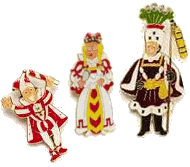 In the old days the idea that a snake surrounds the world and regulates it was known to many peoples.
She was for instance called Ouroboros. Christians called her Uriel, the archangel of the North and of the
Earth. We may read Ouroboros as 'Ur and Bur'. Bur (Buri) was regarded as the Nordic god of creation
and the first ancestor of the Aesir. In Cologne and elsewhere the Bur (Deutsch: Bauer, peasant)
became a symbol figure of regional pride. The Kölner Bur (Buur) in a way represents the savior. His cult
is linked to the cultivation of the regional dialect, that resembles the Niederdeutsch (lowland) and Dutch
dialects or languages. As a holy king the Bur resides over carnival, which formerly was the spring
festival of the Virgin, who in Cologne is a man now. Her Germanic name Erda (the Norn Urd) turned to Eortha in
England. Late Nordic folklore called her Jørd. As Snake of the Earth she was called Jørmungand
(maybe: German woman). Skadi was her name as the woman of the world-ash Yggdrasil (Old Nordic: askr).
Under the name Gerd she was commonly seen as the partner and wife of the Ass (yes, one of the Aesir) Freyr
(Suitor, Lord). The Edda also presents the 'one man too many'. This naughty servant pesters and forces the
shining virgin, allegedly in the service of his lord. Skirnir had been an elderly pagan priest who had come
under the influence of Christianity. When those heathens realized that their times ended with Kaiser Karl,
they put the blame on the Goddess. But in Christian times men just didn't respect that Virgin no more, and the
same was true for all other women. The problem was that there was no Lord yet who could defend her honor.
In the old days the idea that a snake surrounds the world and regulates it was known to many peoples.
She was for instance called Ouroboros. Christians called her Uriel, the archangel of the North and of the
Earth. We may read Ouroboros as 'Ur and Bur'. Bur (Buri) was regarded as the Nordic god of creation
and the first ancestor of the Aesir. In Cologne and elsewhere the Bur (Deutsch: Bauer, peasant)
became a symbol figure of regional pride. The Kölner Bur (Buur) in a way represents the savior. His cult
is linked to the cultivation of the regional dialect, that resembles the Niederdeutsch (lowland) and Dutch
dialects or languages. As a holy king the Bur resides over carnival, which formerly was the spring
festival of the Virgin, who in Cologne is a man now. Her Germanic name Erda (the Norn Urd) turned to Eortha in
England. Late Nordic folklore called her Jørd. As Snake of the Earth she was called Jørmungand
(maybe: German woman). Skadi was her name as the woman of the world-ash Yggdrasil (Old Nordic: askr).
Under the name Gerd she was commonly seen as the partner and wife of the Ass (yes, one of the Aesir) Freyr
(Suitor, Lord). The Edda also presents the 'one man too many'. This naughty servant pesters and forces the
shining virgin, allegedly in the service of his lord. Skirnir had been an elderly pagan priest who had come
under the influence of Christianity. When those heathens realized that their times ended with Kaiser Karl,
they put the blame on the Goddess. But in Christian times men just didn't respect that Virgin no more, and the
same was true for all other women. The problem was that there was no Lord yet who could defend her honor.
The third eye of the snake
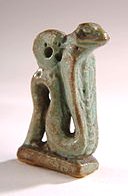 In the old Egypt the Uraeus snake (Ur) was seen as the sheltering deity of the pharaoh, often she was put
up on front of his forehead. In mythology the snake Uraeus was a partner of Ra, the god of
the Sun. As the third eye on Ra's forehead the snake Ur would symbolize divine intuition. Here
we see the snake Uraeus in the form as a cobra. But pagan Egyptians would eventually mistake this uncanny
force for the, suddenly attacking, evil snake Apophis! Pagan Egyptians would eventually revere even evil
monsters. In the old North some knew these monsters better. Nordic myths tell that the Snake of Middle
Earth is neither a snake nor a dragon nor a whale-fish, but a worm (Old Nordic: ormr). She is the
one who sees to it that the coasts are not hit by storm floodings. But one big problem was that in the
North too the Greys tended to promote the rather simple people from the South to the top, making them talk big
while keeping the Nordic low. And when an inundation occured, as it happened, these guys wrathfully blamed
that worm. Just when people needed it most, in times of crises, good inspiration often took a leave.
In the old Egypt the Uraeus snake (Ur) was seen as the sheltering deity of the pharaoh, often she was put
up on front of his forehead. In mythology the snake Uraeus was a partner of Ra, the god of
the Sun. As the third eye on Ra's forehead the snake Ur would symbolize divine intuition. Here
we see the snake Uraeus in the form as a cobra. But pagan Egyptians would eventually mistake this uncanny
force for the, suddenly attacking, evil snake Apophis! Pagan Egyptians would eventually revere even evil
monsters. In the old North some knew these monsters better. Nordic myths tell that the Snake of Middle
Earth is neither a snake nor a dragon nor a whale-fish, but a worm (Old Nordic: ormr). She is the
one who sees to it that the coasts are not hit by storm floodings. But one big problem was that in the
North too the Greys tended to promote the rather simple people from the South to the top, making them talk big
while keeping the Nordic low. And when an inundation occured, as it happened, these guys wrathfully blamed
that worm. Just when people needed it most, in times of crises, good inspiration often took a leave.
The best goddess of Egypt was arguably Maat, the divine order. Already the
name reminds us of the Indo-European word mother (Latin: mater). It fits well to this
name that the most important male god was Ptah, reminding of the Indo-European word
father (Latin: pater). Ptah was nearly the only god who was seen and shown as a human.
We may well think that this cult came to Egypt with white conquerors from Europe
and the Middle East. In the times after the old empire however Hathor, the alleged queen of
heaven and cow-deity, became especially important. Her's is another Dor-Name. Also the
ado around the star Sirius (Sothis) shows that at that time the Greys were badly mighty in
Egypt. They then tried to make Cleopatra become the empress of Europe. Just imagine the
consequences! All the western world might not be replete with churches
today but with temples of the jackal-god Anubis, wherein mountains of mummies would be mouldering!
The big difference was that, while the Sirius was occasionally regarded as a powerful star in the
Orient, Europeans at least got a hunch that just this star was bringing bad heat and bad luck.
How Dietrich became a monster

This image detail of the Basel Münster
(the word originally meant monastery) shows Dietrich von Bern (aka Thidrek) in his typical
stance of fighting. We recognize the three things that this bâleful Münster-monster wears on top
as cranes. Only UTR makes clear now that congeras were meant with those bizarre fantasies, good and bad ones.
Some were able to part them a bit, but others held on to them or fought against them altogether.
The truth is that Wittig had never had any business with a Dietrich from Switzerland. The legend of
the combat of these two but shows the invisible division line between friends and foes of the
Earth Goddess. Already before the days of the Roman invasion that line parted Celtic Germans
and Teutonic Germans. Teutons (Titans) had dominated the North, but many were annihilated by
the Romans. Some survivors in Britain and Belgium became Celts, and turned to the tribal god
Teutates (Toutatis).
Unfortunately the good mermaid often only secretly shows what she really can do, or not at all.
But many fighters, often bad guys who hated the Goddess, were powered-up by Greys, and later became
the fantasy heroes of stupid Christian tales. One bizarre tale has it that Dietrich von Bern in the end
became immortal because an arrow got stuck in his head. Since when make arrows people live forever?
But yes, even this tale makes sense. Dead Dietrich turned a bit into a congera, who indeed is immortal
due to the life-support cranes (hoses) in her body. Weird legends come up when a dead person seems to
appear again as a changeling-spirit. Dietrich transformed a little into a congera. Comparable is
the tale that Siegfried's skin became callous like that of a dragon after he had killed one.
Obviously the magic of the good monster would even be helpful for his foes!
9. The Fantasy Monster who heals
In the age of Christianity the Goddess was sometimes seen as some kind of fish or sea monster. But some such myth would also veil a strange or smutty real story.
The fantastic halibut
 This nice piece of artwork from the city of Hagen (worked up by me) is maybe the only one that exists of the
fantasy fish Buttje. Versus those many often absurd or bitter tales of heroic fiction the nixe liked to put
up her small success stories. Ewa rarely fared well with wild ruffians, but she knew better how
to handle honest fishers. Much more true than many a legend is the Nordic fairy tale of the fisherman
Timpe and his upstart wife. To them the Goddess appeared as the fish Buttje. That wonder fish not only
fulfills wishes. But this fish can also heal, absolutely, and that is the reason why the halibut (Deutsch:
Heilbutt) received it's name. But it is typical that some friend of the butt and his wife have to keep
their heads down, in spite of their wishful thinking that they already are the royals of the world. That
elevated place is reserved for the wish-fish herself and her love-one. Fantasies may help her to reach it.
This nice piece of artwork from the city of Hagen (worked up by me) is maybe the only one that exists of the
fantasy fish Buttje. Versus those many often absurd or bitter tales of heroic fiction the nixe liked to put
up her small success stories. Ewa rarely fared well with wild ruffians, but she knew better how
to handle honest fishers. Much more true than many a legend is the Nordic fairy tale of the fisherman
Timpe and his upstart wife. To them the Goddess appeared as the fish Buttje. That wonder fish not only
fulfills wishes. But this fish can also heal, absolutely, and that is the reason why the halibut (Deutsch:
Heilbutt) received it's name. But it is typical that some friend of the butt and his wife have to keep
their heads down, in spite of their wishful thinking that they already are the royals of the world. That
elevated place is reserved for the wish-fish herself and her love-one. Fantasies may help her to reach it.
The black sea-swine
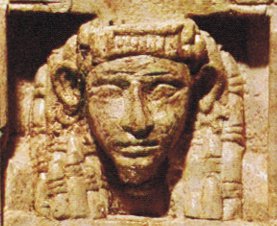 Here we see a typical Phoenician ivory idol. That ancient Lebanese girl looks not as nice as
Fairuz but still better than the common 'Goddess in the Window'. The typically three windows of
such an idol symbolize the several layers of the betyle of a congera. So now we understand why
Orientals past and present show the strong tendency to invade Europe to acquire some better
looking girls. Unwelcome migrants may also have been at the origin of the bizarre Christian
legend that Holy Mary once traveled 'selfthird' (in a pack of three) to France, with the children
of Jesus and that whore, to engender the kings of France. Of the much later Frankish Merovingians a
legend but tells that their eponymous (name-giving) first ancestor Merowech had been engendered
by a sea monster! That tale has it that one son (name withheld) of the Frankish ruler Chlodio
Faramund once was alone with his father's wife at the seashore. It was summer, it was hot, so
surely they undressed and took a bath. Suddenly, allegedly, a monster came out of
the ocean and took this woman! That monster allegedly looked like a swine, and therefore
it's son Merowech allegedly possessed a skin with swine bristles. We may rather think that
some human broke the marriage here. But apparently, in the moment of temptation and of the
distress of conscience, right then an onslaught of N-rays occurred. Jakob Grimm pointed out
that the Merovingians, who came from the East to the old Frankish lands (Holland), originally were called
Maurungani. We can translate this into 'a Moor's young ones'. So those mythical swine bristles of
Merowech maybe circumscribed the typical frizzy head wool of the Negroes, that was maybe curled up to
form those smutty shags called dreadlocks (who get out of shape when they wash them). Celtic-Christian
cloister brothers often tended to twist such murky stories in a similar way.
Here we see a typical Phoenician ivory idol. That ancient Lebanese girl looks not as nice as
Fairuz but still better than the common 'Goddess in the Window'. The typically three windows of
such an idol symbolize the several layers of the betyle of a congera. So now we understand why
Orientals past and present show the strong tendency to invade Europe to acquire some better
looking girls. Unwelcome migrants may also have been at the origin of the bizarre Christian
legend that Holy Mary once traveled 'selfthird' (in a pack of three) to France, with the children
of Jesus and that whore, to engender the kings of France. Of the much later Frankish Merovingians a
legend but tells that their eponymous (name-giving) first ancestor Merowech had been engendered
by a sea monster! That tale has it that one son (name withheld) of the Frankish ruler Chlodio
Faramund once was alone with his father's wife at the seashore. It was summer, it was hot, so
surely they undressed and took a bath. Suddenly, allegedly, a monster came out of
the ocean and took this woman! That monster allegedly looked like a swine, and therefore
it's son Merowech allegedly possessed a skin with swine bristles. We may rather think that
some human broke the marriage here. But apparently, in the moment of temptation and of the
distress of conscience, right then an onslaught of N-rays occurred. Jakob Grimm pointed out
that the Merovingians, who came from the East to the old Frankish lands (Holland), originally were called
Maurungani. We can translate this into 'a Moor's young ones'. So those mythical swine bristles of
Merowech maybe circumscribed the typical frizzy head wool of the Negroes, that was maybe curled up to
form those smutty shags called dreadlocks (who get out of shape when they wash them). Celtic-Christian
cloister brothers often tended to twist such murky stories in a similar way.
From the point of view of UTR there is another
swinish aspect of this. There are fractal links to the Fe congeras (aka children of Iria, swines in space).
The one exceptional showpiece planet there is that of Fe-Nike, serving as false evidence that things
are not that bad over there. Fe-Nike occasionally attempts to clutch at us with fractal links, for instance
as a nixe. She helped, or rather not, with Nikias, that most-famous painter of the age of antiquity. She
also fostered the really poor culture of the Phoenicians, and also the Anatolian cult of Saint Nikolaus
aka Santa or Father Christmas, rejected by many Christians (who but often like the Spiderman). We should
mentally stay away from those 'Fays' in space, lest they drag us down with them into their unavoidable doom.
The shimmering stone
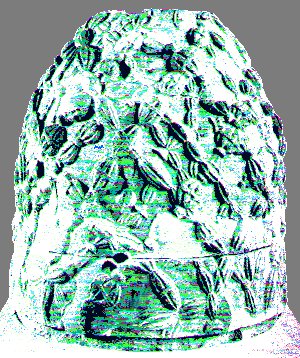
The Betyle, this most precious stone of Earth, is often represented by a holy stone. This old omphalos (navel) from Delphi shows some fine masonic artwork too, an agrenon. That was a network that once adorned the stone.
The cult around the omphalos remained when Apollon abolished the cult of Ga(-ia). Apollon now became the god of the plague and also of light. People celebrated his victory over the snake. But at the same time the spiritual contact to the Earth weakened. The Etruscans by and by started to believe in somber gods of the dead. One of them was Tufluns, whose name turned into our word 'devil'. In Delphi at about the same time they created the above shown omphalos. Officially it symbolized the navel of the world. But it secretly really showed the shimmering body of god. The above omphalos gives special proof for this interpretation since it is covered with a network called agrenon. Women knitted such nets to ornate an omphalos for a festivity.
An apple for a Reich!

Since I am the savior of this developing planet I am supposed to become the king of kings. So this could be my orb. It's an apple in a knitted coat, a nice creative idea of some woman. Such an orb was a holy symbol for the realm of many a Deutsche Kaiser. The mythical sense of this symbol is explained by the Nordic saga of the Blikjandabol (wrongly: Blikjandabål, curtain of doom; originally maybe: blinking apple). That object is mentioned in the Edda. Possibly one vålva (voalva, seer) had envisioned that shimmering object. The most important songs of the Edda originate from such a mythical vålva. One of them was the Saxon woman Gefjon; a witch, entertainer and whore who dallied with king Gylfi. But the stuff that these two authors of the Edda thought out often remained a matter of interpretation. Crass legends too played a role. For instance a tale had it that the Hellusians were having the faces and the mimics of humans, while their bodies and their limbs were those of animals. We may think that these creatures, described by Tacitus, were in fact seals and sea-hounds. Twisted tales about them originated from Romans who sailed the North Sea. From such a tale the legend emerged of Hel, the somber goddess of the dead in the deep. She may be hiding in the dark, but already her name shines like that of Helios, the Hellenic god of the Sun from Rhodos. Allegedly Hel lies in her bed behind a blinking curtain, being half human and half black-and-blue. But just that goddess also appeared in the North under the name Helen (Hlin), and was regarded as the goddess of consolation and of mercy. There are modern fiends of nature who even dislike seals because of all this. Such types would maybe only accept the Earth Goddess as a black stone, the famous 'black box'. A black box is a metaphor for a mysterious and scary and complicated thing that experts rather won't open. It might be Pandora's Box. We now know that the Earth Goddess rather keeps a distance from weak and bad humans. But noble and good humans often must suffer the attacks of N-rays as they come to like Sofia Ewa. It's a tricky quagmire.
10. The Navel of the World
Often the 'mental paupers' terminated their mental development with the decision to simply reject the Earth Goddess. But while Ewa had to part as a 'beast' she often found new honors as a symbol of the world, for instance as a carefully placed costly stone or a menhir. It was often a moment of holy joy when at midwinter the sun would make this stone shine. In old Germany that festive day was called the day of Berchta or Bertha, of the 'Bright One'.
The decline of heathenism
In ancient Delphi several navels were erected, as a symbol for the good force of the deep. But local priests taught that Delphi actually was the navel of the world! Only one famous Greek wise man of seven thence realized that this lore was incorrect. And just this one later was having special troubles. Greys dislike people who are really wise. In holy Delphi at that time the cult of Apollon ruled, and this often prevented progress of any kind. With the great era of classical philosophy then, the slow decline began of the absurd cult of the Olympian deities. It would be a mistake to now revive that heathenism of the antiquity. Too much of this stuff had a bad tendency and favored rogues. Of Apollon, the conqueror of Delphi, legends report that he was a man of abominable cruelty. Once he gave orders to skin Marsyas, just because this musician had beaten Apollon at a contest. Despite of such crimes Apollon became so liked that followers saw in him a god of light. That classical heathenism of the iron age was not better than Christianity, but here it was worse! Already in the age of antiquity heathens tended to mystify and darken the bad stories. It should not surprise us when some modern experts get fooled by old lies again. Typical infidels are easily duped. When we read in Greek legends that the priestess Opis (possibly: Europa) traveled with Apollon to the holy island of Delos, then this makes some modern experts (who are often men) claim that this tale must have meant some statue of Apollon only. Apollon had ruined the conscience of Greece! The consequence was that the Goddess had to secretly turn away from heathenism with the end of the bronze age. With the Goddess also her wisdom separates from her world. The Bruger (Phrygian Celt) Apollon also ruined her buildup in the East. From the cult of Apollon Christianity grew. Christianity originally was the religion of the tent maker Apollos from Tarsos, who as a Jewish lukewarm proselyte had used the pseudonym Paulus. Paulus had searched among Jews in Syrian Antioch for a better spirit, to only find Jesus. Apollon had at least found a better spirit, at a time when he had become a hermit, and he had bettered himself. The Goddess hopes now that her spell also will make many rogues think twice, and better them. When philosophy came up in Greece many realized that Apollon was not really the god of Delphi. They then started to give other names to their god of light. They called him Pythius in reference to the snake Python (Plutarch 385 B). In Deutschland though he was called Bercht or Brecht, which is more correct.
The pillar of the Earth
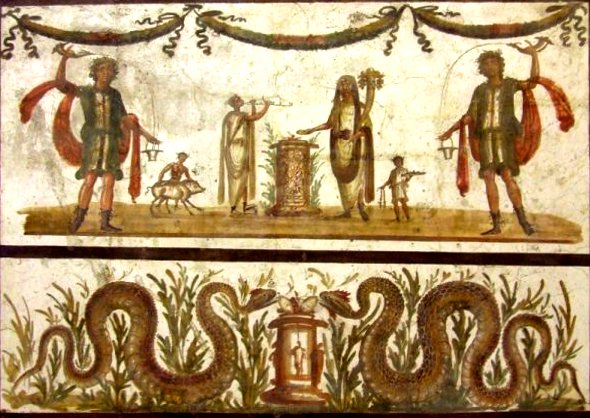
Here a scene is shown from a Roman temple for the common people. In Naples (Napoli) the Lord of the Lares was revered, or rather two lords of that kind. Often the 'Genius Lararius' was depicted with a mother goddess of the Lares and one or two snakes of the deep. In ancient Rome the Lares had been seen as local spirits, who would demand offerings or other things from residents or passers-by. Not by coincidence this cult reminds of the foolish cult of the Elves in modern Iceland. That foolery was another way to make the Earth take over some of the bad karma of the world Lar. The genius was a savior deity. As the Bacchus (bringer of gifts) he served wine. People who got to the idea to turn to him often did so because of the hope to receive protection before ill phenomena and bad luck. The genius was seen as the lord of the house spirits (Lares, Penates), and he had a good connection to the uncanny goddess, the snake of the underground. Here that (double) snake is shown with a pillar, and we realize that the offering altar of the Lararium above was seen as a symbol for the sacred pillar in the deep.
The pillar misunderstood
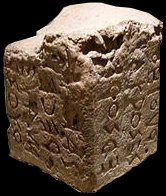 Here is another such symbol of the hidden betyle, the Lapis Niger of Rome. That 'Black Stone' is not really
black, but it served as a symbol comparable to other such stones. That stump of a pillar remained of
the holy grove of king Romulus, when Celts destroyed and burned down Rome. Driven by cosmic N-rays
to take revenge, Roman troops later massacred Celts in Italy and Gaul by the hundreds of thousands. They
did not understand the truly good meaning of that symbol and were fascists and robbers anyway.
The name N-rays refers to Nemesis, the false goddess of revenge. The sky often goads humans to take revenge.
Comparable to the Lapis Niger is the Kaaba, the black box that is today at the center of the great sanctuary
of the Muslims in Mecca. Many fail to understand that this is yet another symbol for the house of the good
and peaceful goddess, who lives right below of it. To use a parable: Mohammed didn't look into it.
Today we may artfully imagine that it contains a 'blinking apple'.
Here is another such symbol of the hidden betyle, the Lapis Niger of Rome. That 'Black Stone' is not really
black, but it served as a symbol comparable to other such stones. That stump of a pillar remained of
the holy grove of king Romulus, when Celts destroyed and burned down Rome. Driven by cosmic N-rays
to take revenge, Roman troops later massacred Celts in Italy and Gaul by the hundreds of thousands. They
did not understand the truly good meaning of that symbol and were fascists and robbers anyway.
The name N-rays refers to Nemesis, the false goddess of revenge. The sky often goads humans to take revenge.
Comparable to the Lapis Niger is the Kaaba, the black box that is today at the center of the great sanctuary
of the Muslims in Mecca. Many fail to understand that this is yet another symbol for the house of the good
and peaceful goddess, who lives right below of it. To use a parable: Mohammed didn't look into it.
Today we may artfully imagine that it contains a 'blinking apple'.
In old Delphi there stood one special pillar of the Apollon temple, that had become a symbol of the body
of God inside of the Betyle. Some scratcher had secretly marked this ordinary pillar with an E. For the
priests this meant their holy word 'Ei', which is a word of affection that they used as they greeted god.
We may see that a hint of God that the reverence of these priests really went to some kind of pillar and
not to Apollon. But many people were just too scared and too ignorant to even try to understand. Even
old-time prophets often had to stop at the outside of the box. A view into the inside was not granted to
them. Only UTR allows to link all those pillars and stones to the Betyle of our 'Snake of the Earth' and
to her body, and eventually to her savior genius (the idealized savior). It must have often remained
mysterious however why above on this old painting two saviors are depicted, and also two snakes!. In
ancient Rome the cult of the Lares was practiced by Romulus too. But his idea, that some
Lares grunt like swines, was later discarded. UTR now teaches that Lares are humanoids
like we are too, who but evolved from gibbons. Therefore it is not correct to depict them with sharp
pig ears and to otherwise confuse them with those pigs in space. Just like most humans do, most of the
Lares keep a distance to their goddess Ga-Leta, not really knowing her. Our two goddesses can only jointly
make themselves well-known to their planets.
The seven-cornered owl-face
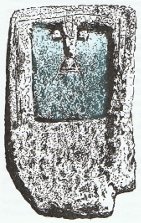 One of the more strange prehistoric icons is shown here.
The stele of Asquera was interpreted
as a face of the mother goddess, with a view at the similar stele of Zebbug from Malta. The
Deutsche archaeologist Frau Sibylle von Cles-Reden red this face as that of an owl, even while
it's too square for that. Once again only UTR can solve this riddle. We may interpret this face
as two semi-portals on the mestab of a congera. There are 16.8 million such portals. Through each of
them a cable runs, that ends in a kind-of capacitor at the skin of a congera. If some planet is
alive then these contacts shimmer and blink. These are quasi the eyes of our Earth Goddess. By way
of these portals her wisdom comes to humankind.
One of the more strange prehistoric icons is shown here.
The stele of Asquera was interpreted
as a face of the mother goddess, with a view at the similar stele of Zebbug from Malta. The
Deutsche archaeologist Frau Sibylle von Cles-Reden red this face as that of an owl, even while
it's too square for that. Once again only UTR can solve this riddle. We may interpret this face
as two semi-portals on the mestab of a congera. There are 16.8 million such portals. Through each of
them a cable runs, that ends in a kind-of capacitor at the skin of a congera. If some planet is
alive then these contacts shimmer and blink. These are quasi the eyes of our Earth Goddess. By way
of these portals her wisdom comes to humankind.
The owls of Athens
 Since the face of an owl resembles such a portal, the myth came up that the owl is the bird of the
goddess of wisdom (Athene). Therefore in the age of antiquity and again today a Greek coin (of one
Euro now) shows an owl. Europe should better not lose that wisdom, even if this means that we carry
“owls to Athens”.
Since the face of an owl resembles such a portal, the myth came up that the owl is the bird of the
goddess of wisdom (Athene). Therefore in the age of antiquity and again today a Greek coin (of one
Euro now) shows an owl. Europe should better not lose that wisdom, even if this means that we carry
“owls to Athens”.
11. The Portals of Wisdom
 This menhir (orthostat) stands in a passage-way tomb in France. On it's surface the
stone has carvings that look like semi-portals. Some called them crooked staffs.
With the help of UTR those symbols are recognized as the portals at the surface of a mestab.
Many big stone arrangements were based on visions of the house of god. The single menhir or the pillar
symbolized the Goddess. The passage-way tomb symbolized the mythical voyage to the house of God.
Megalithic peoples spent terribly much effort on their burial sites, and that paid up. Not a few
of those works of art look impressive today, and they transport a good message. By way of
creativity humans not only developed themselves forwards, and also created perpetual works.
But they also came a little on the track of God's secrets.
This menhir (orthostat) stands in a passage-way tomb in France. On it's surface the
stone has carvings that look like semi-portals. Some called them crooked staffs.
With the help of UTR those symbols are recognized as the portals at the surface of a mestab.
Many big stone arrangements were based on visions of the house of god. The single menhir or the pillar
symbolized the Goddess. The passage-way tomb symbolized the mythical voyage to the house of God.
Megalithic peoples spent terribly much effort on their burial sites, and that paid up. Not a few
of those works of art look impressive today, and they transport a good message. By way of
creativity humans not only developed themselves forwards, and also created perpetual works.
But they also came a little on the track of God's secrets.
Portals for adepts only
 Here we see more portals from one especially well adorned passage-way tomb. These
portals are all encircled several times. They let us imagine how the portals of the betyle
work, who reach from the lowest level nine of the mestab up to level five at the border
of rotation. Now, all this will mean hardly anything to many of my readers, it is not
what interests them. Many once had and still have only one big question that they ask God:
“How can I, yes AYE, live on after I die?” One time with real honesty:
God is often glad that this won't happen.
Here we see more portals from one especially well adorned passage-way tomb. These
portals are all encircled several times. They let us imagine how the portals of the betyle
work, who reach from the lowest level nine of the mestab up to level five at the border
of rotation. Now, all this will mean hardly anything to many of my readers, it is not
what interests them. Many once had and still have only one big question that they ask God:
“How can I, yes AYE, live on after I die?” One time with real honesty:
God is often glad that this won't happen.
If you learn to know the UTR today, on one hand you will realize that with it's help
old and modern riddles are easily cleared up. But as people try to spread the word
they will often only encounter disinterest and resentment. The established experts
know no such house of God. Some interpret such carvings
only as the idle works of primitive shepherds. Often someone who knows more and tries to
spread the word is not invited to meetings. He will have strange bad luck and even will
experience nasty miracles. The Earth Goddess remained half-way in hiding already in the old
days, she keeps heeding her secrets today. In the old days only adepts were invited to be
introduced into her mysteries (confidential teachings). That was of hardly any interest for
the goofs. These preferred to chat and dine over bread and wine. Just like
this true religion still work today.
